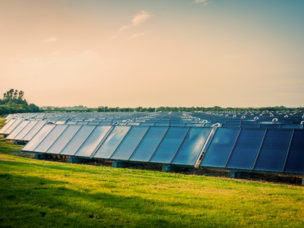Stay in the know
Subscribe to the Real Estate Blog and we’ll send you an email each time something new is posted.
Subscribe to the Real Estate Blog and we’ll send you an email each time something new is posted.
Blogs
Real Estate Blog
2014 Massachusetts Solar Update
SREC II: It seems we hardly knew you.
In April of 2014, the Massachusetts Department of Energy Resources (DOER) published amendments to 225 CMR 14.00 creating the next generation of the Solar Carve-Out Renewable policy known as SREC II. The major differences between the SREC II program and its predecessor was (a) the creation of SREC factors based on four different market sectors, and (b) a declining auction bid price for SRECs over the life of the program. The Managed Growth sector contains all those projects which do not meet the criteria for the other three sectors (which cover residential, solar canopy, emergency power, community solar, units located on landfills or Brownfields (the definition of which is the subject of a draft DOER guideline) and roof top along with ground mounted units with capacity greater than 25 kW with 67% or more of the output used on-site). Unless large commercial ground mounted projects (the type of projects that underwent a growth explosion under SREC I) are built on landfills or Brownfields, they would need to qualify under the Managed Growth sector. SREC II limited the number of these large projects by capping the Managed Growth sector at 26 MW for Compliance Year 2014 and at 80 MW for Compliance Year 2015.
On May 27th, DOER announced the projects that would receive an Assurance of Qualification (AoQ) for the SREC II Managed Growth Annual Capacity Block for years 2014 and 2015. A few days later, DOER purchased 10,000 SRECs at a weighted average price of $280.80 to satisfy the remainder of its regulatory obligation for 2013 eligible SRECs.
With all those loose ends tied up, and an uncertain political climate looming with a new administration at year end and two competing bills in the legislature that dealt with net metering on different paths, many in the solar community were surprised to learn of a new legislative proposal brokered by DOER that involved the regulated utilities and a number of solar stakeholders. On the heels of the infant SREC II program, DOER held a stakeholder meeting on June 11th summarizing the legislative proposal that would become effective July 1, 2015, if adopted. The draft proposal:
- Provides a statutory framework for achieving 1,600 MW of solar PV by 2020
- Permanently lifts the cap on solar net metering
- Replaces the SREC with a Declining Block incentive program
- Limits project size to 5 MW AC
- Restructures phase 2 net metering and virtual metering credits
- Proposes a minimum billing rate for all utility customers
Hello, Declining Block.
One of the advantages of the proposed Declining Block scheme, particularly for larger facilities, is that lenders will be able to underwrite projects easier, as the tariff based Declining Block rate will be fixed for a 15 year period, which differs from the current revenue stream combination of a power purchase agreement coupled with a tradable SREC of fluctuating value over a 10 year period. The current big unknown is the value to be assigned to the Declining Block rate, which will be the subject of upcoming DOER stakeholder meetings and followed by filing a petition with the Massachusetts Department of Public Utilities (DPU) to approve the Declining Block rate as a tariff.
Not all solar participants feel a change is needed to a performing SREC market that has helped to achieve the existing 600 MW of projects in the Commonwealth. After a lengthy stakeholder process was just completed to create the new market sector factors, some speculate this change is triggered by the need to lift the net metering caps, which should not be directly tied to SRECs.
The choice is yours (for a while).
The proposed legislation will not affect existing SREC I or SREC II projects developed before approval of the DPU tariff, which is estimated to be in July 2015. Projects obtaining an AoQ prior to the effective date of the tariff will be safe harbored under SREC II and existing net metering rules. Projects receiving an AoQ during the 6 month transitional period following the tariff effective date, could opt for either the SREC II or Declining Block program, subject to a proposed $60/kW deposit against completion for choosing SREC II. Subsequent to the 6 month transitional period, all projects without an AoQ will be in the Declining Block scheme and new metering framework.
All good things come at a price.
The tradeoffs in the proposed legislation which directly correlate to net metering include monthly bills for all utility customers, including those solar projects which produce more electricity than they use and were previously able to pay nominal or no fees to the utility. This effectively spreads the distribution and infrastructure costs to all utility customers. The distribution credit for virtual net metering systems will also be removed, again to assist in shifting costs for use of the utility infrastructure.
Revised House Bill 4185, which was endorsed by both the New England Clean Energy Council and the Solar Energy Industries Association was reported favorably by the Joint Committee on Telecommunications, Utilities and Energy and has been referred to and is currently under consideration by the House Ways and Means committee and proponents are hoping will pass before the legislative session ends on July 31st.


